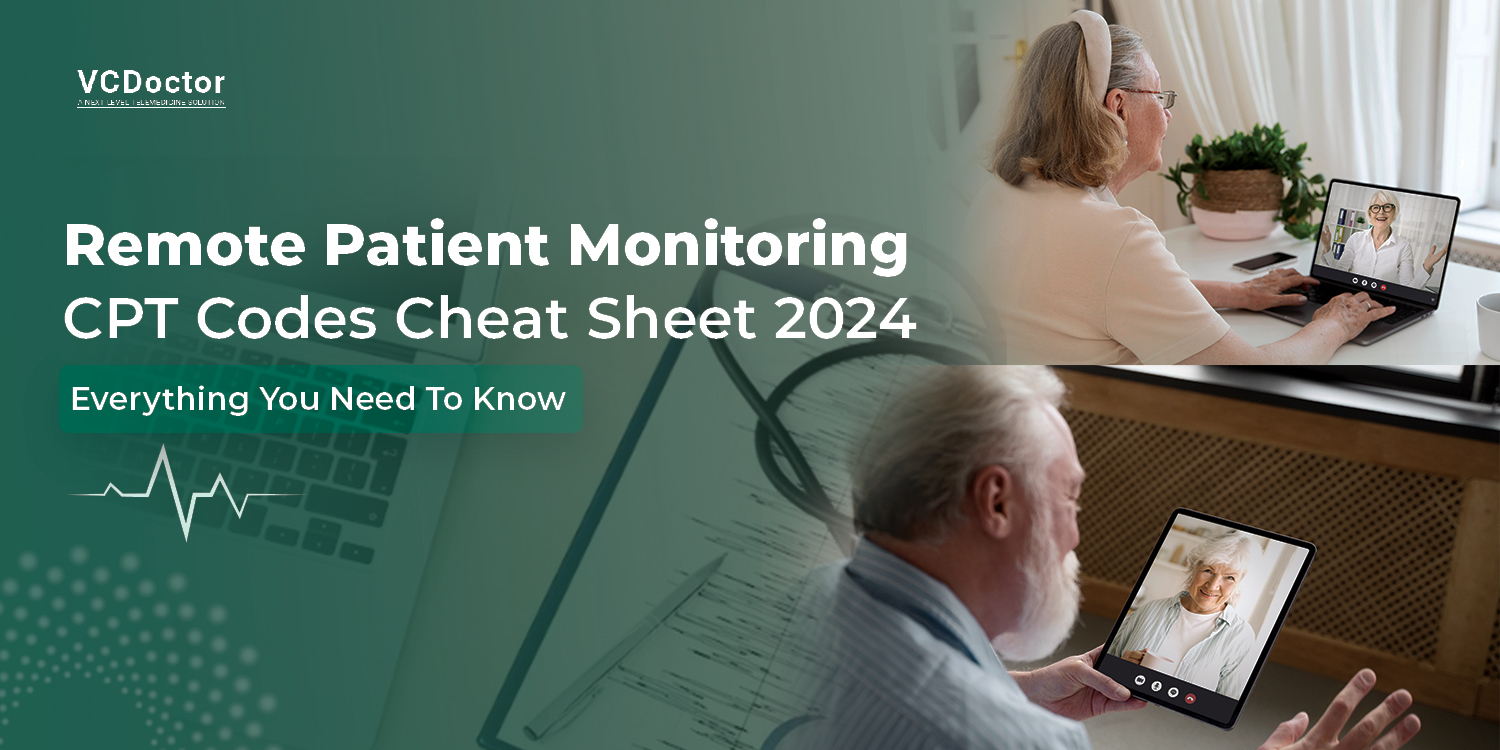RPM CPT Codes Cheat Sheet 2024: Everything You Need To Know
The remote patient monitoring market size could reach $25 billion over the next few years. Driving this growth is the post-pandemic demand for convenient yet secure healthcare. But how can providers ensure timely payments? That’s where rpm cpt codes play such a big role.
If you also offer RPM services, this cheat sheet is for you. Find what rpm cpt codes are, why they matter, and more in this blog.
Table of Contents
- What are remote monitoring services?
- Why are remote patient monitoring CPT codes important?
- Remote patient monitoring CPT codes 2023-24: Details
- Holter Monitor CPT Code Breakdown
- VCDoctor: Telehealth for Peace of Mind
- Wrapping Up!
- Remote Patient Monitoring Cpt Codes FAQs
What are remote monitoring services?
RPM services help providers (big and small) keep check on patients from a distance:
- RPM uses wearables apps, or home gadgets for remote health data collection.
- Data includes vital signs like blood pressure, heart rate, blood sugar, and weight.
- Collected information is securely transmitted to healthcare providers.
Modern RPM services use a combination of advanced tools and technology to collect, store, and analyze patient data.
Benefits for Patients and Providers:
- Early Intervention: RPM helps spot health issues early for better outcomes.
- Improved Care: Real-time data lets providers customize care plans.
- Patient Involvement: RPM lets patients see their data, getting them more involved.
- Fewer Hospital Returns: Managing conditions early can cut down on hospital trips.
Common Uses of RPM in Healthcare:
Remote patient monitoring revolutionizes healthcare. It offers continuous, data-driven care from home. Patients and providers both benefit. It improves health outcomes and care management.
- Manage Choronic patients: RPM helps patients with diabetes, heart failure, or COPD.
- Post-Surgical Care: RPM checks on recovery progress after surgery.
- Mental Health Care: RPM tracks symptoms and treatment for mental health conditions.
Why are remote patient monitoring CPT codes important?
Telehelath is now an essential aspect of RPM services in the USA and Europe. Remote patient monitoring CPT codes ensure providers are reimbursed accurately for the services they offer.
Here’s a breakdown of the key CPT codes for RPM in a simpler way:
- Think of them as price tags for different types of RPM services.
- There are a few main codes, each covering different aspects of remote monitoring.
- These codes determine how much doctors get paid for things like setting up monitoring devices and reviewing patient data remotely.
Here is a list of the most relevant Remote Patient Monitoring CPT Codes (including telemedicine CPT codes ) for RPM service providers:
- 99453 CPT Code
- 99454 CPT Code
- 99457 CPT Code
- 99458 CPT Code
- 99091 CPT Code
Remote patient monitoring CPT codes 2023-24: Details
In 2024, there are a few key RPM codes you’ll want to remember. These CPT codes apply to remote patient monitoring work (RPM) and telehealth.
For First-time Patients (Initial Setup):
- 99453: This code covers the initial setup of your RPM program for a patient. It includes providing the necessary monitoring equipment, educating the patient on its use, and ensuring data transmission is functional.
For Monthly Monitoring:
- 99454: This is the monthly service code for RPM. It covers the ongoing data collection process from the patient’s monitoring device. This code ensures at least 16 days of data are captured within 30 days.
For Interactive Communication:
- 99457 & 99458: These codes are used when your clinical staff interacts with the patient about their collected data.
- 99457: This code applies when the communication takes at least 20 minutes of clinical staff time.
- 99458: This code signifies a more in-depth discussion, requiring 60 minutes or more of clinical staff time with the patient.
Telehealth Considerations:
- 99091: While not exclusively for RPM, this code can be relevant for certain telehealth services related to remote monitoring. However, due to its broader application, consulting a healthcare billing expert is crucial to ensure its proper use within your specific telehealth encounters.
Staying Informed:
- Coding guidelines can change, so it’s important to stay up-to-date.
- Refer American Medical Association (AMA) for updated official CPT codes.
Holter Monitor CPT Code Breakdown
Here’s a quick breakdown of the CPT code for Holter monitor services:
The Code:
- 93224-93227: These are the CPT codes used for Holter monitor services. The specific code used depends on the duration of monitoring.
What it Covers:
These codes encompass the technical component of Holter monitoring, which includes:
- Applying the Holter monitor to the patient
- Instructing the patient on using the monitor and keeping a diary of symptoms
- Removing the monitor after the recording period
- Technically analyzing the collected data (Note: Physician interpretation is billed separately)
Duration and Specific Codes:
- The specific code within the 93224-93227 range depends on the length of the monitoring period
- These codes are typically used for up to 48 hours of continuous recording.
VCDoctor: Telehealth for Peace of Mind
Are you looking for a telemedicine solution with advanced RPM features? If yes, then VCDoctor is the perfect telemedicine and RPM solution you need.
VCDoctor works great with all your home health checkup tools! This includes:
- Blood pressure cuffs
- Heart rate monitors
- Pulse oximeters
- Glucometers (for blood sugar)
- Weighing scales
- Thermometers
- Spirometers (for lung function)
Why choose VCDoctor?
VCDoctor is your all-in-one telehealth solution. It is fully HIPAA compliant and supports RPM too. And, the best part- it is a 100% white-label web-based platform. Here are its key features:
- Schedule appointments: See your availability and book appointments in a flash.
- Track patients: Keep all your patient info and charts in one place.
- Show your expertise: Add your specialties so patients know what you’re best at.
- Work with your team: Collaborate with assistants and patients for smooth care.
- See patients virtually: Conduct video calls for appointments and check-ins.
- Send prescriptions: Provide prescriptions electronically for added convenience.
- Chat with patients: Message patients easily to answer questions or follow up.
- Review past visits: Easily see past appointments, messages, and prescriptions.
- Monitor vitals (optional): Keep an eye on patients’ vitals remotely (if using compatible devices)
Try VCDoctor today for remote consultations and patient monitoring. Book a demo now!
Wrapping Up!
So, there you have it! This CPT cheat sheet gave you the lowdown on those all-important RPM CPT codes, kind of like price tags for different remote monitoring services. With RPM, providers can catch issues early, tailor care plans on the fly, and keep patients more involved in their health.
Remember, coding can change, so keep an eye out for updates (the AMA website is your friend here).
Thinking about taking your practice remote? Solutions like VCDoctor can be your partner in crime. It works great with all those cool home health gadgets and keeps things nice and simple.
Ready to see how VCDoctor can streamline your practice? Book a demo today and see what the future of healthcare looks like – remote, convenient, and focused on keeping patients healthy!
Remote Patient Monitoring Cpt Codes FAQs
Q: Are CPT codes for telehealth important?
Absolutely! Telehealth CPT codes are crucial for healthcare billing. They tell insurance companies exactly what you offer in your remote care services.
- It guarantees accurate billing
- It gets you paid the right amount (right code translates to right reimbursements)
- It keeps things compliant
Q: Can you share a table for remote patient monitoring CPT codes?
This table gives you a quick rundown of key things to know about RPM CPT code billing:
| Step | CPT Code | Description |
| Set up | 99453 CPT Code | One-time fee (equipment and training) |
| Monthly monitoring | 99454 CPT Code | Covers device supply, data collection & reports. |
| Clinical Review | 99457 CPT Code | Reviewing patient data |
| Telehealth | 99091 CPT Code | Not exclusive to RPM |
Q: Who does the 99453 CPT code and 99454 CPT code apply to?
These codes apply to patients using Remote Patient Monitoring services.
- 99453 CPT Code: Applies to new patients starting your RPM program (one-time fee).
- 99454 CPT Code: Applies to any active patient in your RPM program (covers monthly data collection).
Q: Is there any specific timeline for reporting?
Yes, each remote patient monitoring CPT code has its time period.
- 99453 CPT code: Billed once for new patients.
- 99454 CPT code: Billed monthly, needs 16+ days of data (30-day period).
- 99457 CPT code: 20 minutes of review time.
- 99458 CPT code: 60+ minutes of review time.
- Telehealth (99091): No set time, used for ~30-minute consultations (may apply to RPM).
Q: Can I use VCDoctor telemedicine platform for clinics?
We offer HIPAA-compliant telemedicine platforms for patients, providers, and clinics. You can add multiple locations, consult with patients, and manage them all from one single platform. Book a free demo and see how it works now!




